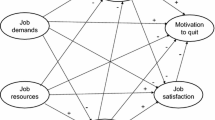Abstract
The study aimed at identifying the sources of stress, and investigating their effects on job satisfaction and psychological distress among 106 university teachers (86 males, 20 females) from four tertiary institutes in Hong Kong. Another purpose of the study was to examine the moderating effect of locus of control on stressor-strain relationships. A factor analysis of the faculty stressors revealed six factors: recognition, perceived organizational practices, factors intrinsic to teaching, financial inadequacy, home/work interface, and new challenge. A series of stepwise multiple regressions demonstrated that recognition, perceived organizational practices, and financial inadequacy were best predictors of job satisfaction, whereas perceived organizational practices and home/work interface were the best predictors of psychological distress. Further, external locus of control was associated with low job satisfaction and psychological distress. A series of hierarchical moderated regressions demonstrated a moderating effect of locus of control on some of the stressor-strain relationships.
Similar content being viewed by others
REFERENCES
Blix, A., Cruise, R., Mitchell, B., & Blix, G. (1994). Occupational stress among university teachers. Journal of Educational Research, 36 (2), 157–169.
Brown, R. D., Bond, S., Gerndt, J., Krager, L., Krantz, B., Lutkin, M., & Prentice, D. (1986). Stress on campus: An interactional perspective. Research in Higher Education, 24 (1), 97–112.
Carnegie Foundation for the Advancement of Teaching (1986). The satisfied faculty. Change, 18 (2), 31–34.
Cartwright, S., & Cooper, C. L. (1997). Managing Workplace Stress. Thousand Oaks, CA: Sage.
Cohen, J., & Cohen, P. (1983). Applied Multiple Regression/Correlation Analysis for the Behavioral Sciences. Hillsdale, NJ: Lawrence Erlbaum Associates.
Cooper, C. L., & Williams, S. (1996). Occupational Stress Indicator: Version 2. England, North Yorkshire: RAD Ltd.
Cummins, R. (1989). Locus of control and social support: Clarifiers of the relationship between job stress and job satisfaction. Journal of Applied Social Psychology, 19 (9), 772–788.
Dua, J. K. (1994). Job stressors and their effects on physical health, emotional health, and job satisfaction in a university. Journal of Educational Administration, 32 (1), 59–78.
Durham, J. (1992). Stress in Teaching (2nd Ed.). London: Routledge.
Fisher, S. (1994). Stress in Academic Life: The Mental Assembly Line. Buckingham: The Society for Research into Higher Education & Open University Press.
Ganster, D. C., & Fusilier, M. R. (1989). Control in the workplace. In C. L. Cooper and I. T. Robertson (Eds.), International Review of Industrial and Organizational Psychology 1989 (pp. 235–280). Chichester, UK: John Wiley.
Gmelch, W. H., Lovrich, N. P., & Wilke, P. K. (1984). Stress in academe: A national perspective. Research in Higher Education, 20, 477–490.
Gmelch, W. H., Wilke, P. K., & Lovrich, N. P. (1986). Dimensions of stress among university faculty: Factor-analytic results from a national study. Research in Higher Education, 24 (3), 266–286.
Hagedorn, L. S. (1996). Wage equity and female faculty job satisfaction: The role of wage differentials in a job satisfaction causal model. Research in Higher Education, 37 (5), 569–598.
Hensel, N. (1991). Realizing gender equality in higher education: The need to integrate work/family issues. Ashe-Eric higher education report no.2. Washington, D. C.: The George Washington University, School of Education and Human Development.
Jamal, M. (1999). Job stress, Type-A behavior, and well-being: A cross-cultural examination. International Journal of Stress Management, 6 (1), 57–67.
Kelly, J. D. (1989). Gender, pay, job satisfaction of faculty in journalism. Journalism Quarterly, 66 (2), 446–452.
Kerlinger, F., & Pedhazer, F. (1973). Multiple Regression Analysis. New York: Horrowitz.
Narayanan, L., Menon, S., & Spector, P. E. (1999). Stress in the workplace: A comparison of gender and occupation. Journal of Organizational Behavior, 20 (1), 63–73.
Roberts, J. A., Lapidus, R. S., & Chonko, L. B. (1997). Salespeople and stress: The moderating role of locus of control on work stressors and felt stress. Journal of Marketing Theory and Practice, 5 (3), 93–108.
Schonfeld, I. S. (1990). Psychological distress in a sample of teachers. The Journal of Psychology, 124 (3), 321–338.
Sharpley, C. F., Reynolds, R., Acosta, A., & Dua, J. K. (1996). The presence, nature and effects of job stress on physical and psychological health at a large Australian university. Journal of Educational Administration, 34 (4), 73–86.
Siu, O. L., & Cooper, C. L. (1998). A study of occupational stress, job satisfaction and quitting intention in Hong Kong firms: The role of locus of control and organizational commitment. Stress Medicine, 14, 55–66.
Siu, O. L., Lu, L., & Cooper, C. L. (1999). Managerial stress in Hong Kong and Taiwan: A comparative study. Journal of Managerial Psychology, 14 (1), 6–25.
Spector, P. E. (1988). Development of the Work Locus of Control Scale. Journal of Applied Psychology, 61, 335–340.
Spector, P. E.,. & O'Connell, B. J. (1994). The contribution of personality traits, negative affectivity, locus of control and Type A to the subsequent reports of job stressors and job strains. Journal of Occupational and Organizational Psychology, 67, 1–11.
Stone, E. F., & Hollenbeck, J. R. (1989). Clarifying some controversial issues surrounding statistical procedures for detecting moderator variables: Empirical evidence and related matters. Journal of Applied Psychology, 74, 3–10.
Thompson, C. J., & Dey, E. L. (1998). Pushed to the margins: Sources of stress for African American college and university faculty. The Journal of Higher Education, 69 (3), 324–344.
Thorsen, E. J. (1996). Stress in academe: What bothers professors? Higher Education, 31 (4), 471–489.
Williams, S., & Cooper, C. L. (1998). Measuring occupational stress: Development of the Pressure Management Indicator. Journal of Occupational Health Psychology, 3 (4), 306–321.
Wong, T. H. (1989). The impact of job satisfaction on intention to change jobs among secondary school teachers in Hong Kong. Education Journal, 17, 176–184.
Xie, J. L. (1996). Karasek's model in the People's Republic of China: Effects of job demands, control and individual differences. Academy of Management Journal, 39, 1594–1618.
Rights and permissions
About this article
Cite this article
Leung, Tw., Siu, Ol. & Spector, P.E. Faculty Stressors, Job Satisfaction, and Psychological Distress Among University Teachers in Hong Kong: The Role of Locus of Control. International Journal of Stress Management 7, 121–138 (2000). https://doi.org/10.1023/A:1009584202196
Issue Date:
DOI: https://doi.org/10.1023/A:1009584202196




